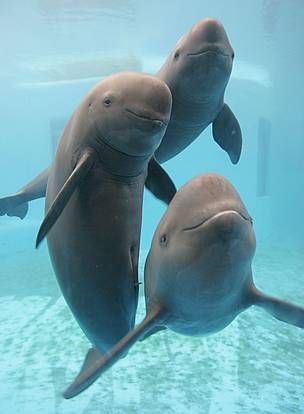We can feel your outrage! But checkout why this bold statement was made below.
Collectively, whales, dolphins and porpoises are known as cetaceans.
Dolphins and porpoises also have many similarities, one of which is their extreme intelligence. The encephalization quotient varies widely between species. The La Plata dolphin has an EQ of approximately 1.67; the Ganges River dolphin of 1.55; the orca of 2.57; the bottlenose dolphin of 4.14; and the tucuxi dolphin of 4.56.
Cetaceans could be smarter than humans According to an article on Wikipedia
In 2015, it was shown for the first time that a species of dolphin, the long-finned pilot whale, has more neocortical neurons than any mammal studied to date including humans. Unlike terrestrial mammals, dolphin brains contain a paralimbic lobe, which may possibly be used for sensory processing. The dolphin is a voluntary breather, even during sleep, with the result that veterinary anaesthesia of dolphins is impossible, as it would result in asphyxiation. All sleeping mammals, including dolphins, experience a stage known as REM sleep. Ridgway reports that EEGs show alternating hemispheric asymmetry in slow waves during sleep, with occasional sleep-like waves from both hemispheres. This result has been interpreted to mean that dolphins sleep only one hemisphere of their brain at a time, possibly to control their voluntary respiration system or to be vigilant for predators. This is also given as explanation for the large size of their brains.
Dolphin brain stem transmission time is faster than that normally found in humans, and is approximately equivalent to the speed found in rats. As echo-location is the dolphin’s primary means of sensing its environment – analogous to eyes in primates – and since sound travels four and a half times faster in water than in air, scientists speculate that the faster brain stem transmission time, and perhaps the paralimbic lobe as well, assist quicker processing of sound. The dolphin’s greater dependence on sound processing is evident in the structure of its brain: its neural area devoted to visual imaging is only about one-tenth that of the human brain, while the area devoted to acoustical imaging is about 10 times that of the human brain. Sensory experiments suggest a great degree of cross-modal integration in the processing of shapes between echolocative and visual areas of the brain. Unlike the case of the human brain, the cetacean optic chiasm is completely crossed, and there is behavioral evidence for hemispheric dominance for vision.
Why cetaceans may be cooler than you
Forever blowing bubbles: Playful dolphins show off their unusual talent for making rings of air under water.
The video above captured the adorable moment a porpoise played in its tank at a Japanese zoo, sucking in air with a straw and then blowing it out to the amazement of crowds.
The clip of the marine mammals was filmed in 2012, but has recently resurfaced online.
It shows the cute porpoise swimming up to a straw and inhaling, before swimming up to glass and blowing out bubbles, much to the amusement of the crowd
It is thought the porpoise was trained by staff at the zoo in Shimonoseki, Yamaguchi Prefecture, Japan, where the trainers take advantage of their natural instinctive behaviour.
In the wild, porpoises blow the ocean floor to drive out small fish hiding in the sand.
So what say you? Are you cooler and more intelligent than Cetaceans?
Sources: Wikipedia, Daily Mail






